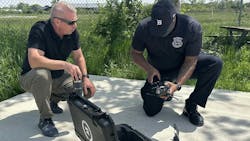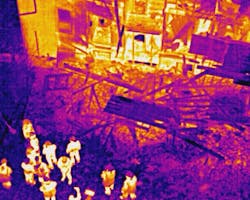Detroit Fire Department 165th Anniversary: Investment in Drones, Records-Management Software
Key Takeaways
- The Detroit Fire Department’s use of drones at the 2024 NFL Draft exemplified the technology’s suitability for understanding and finding access points for emergency response at large public events.
- The Detroit Fire Department used education forums that it conducted at community events that were put on by the city to mitigate potential negative public reaction to drone use.
- Potential negative reaction from firefighters to their department’s installation of software to handle scheduling and record-keeping regarding member training can be countered via transparency about the purpose and benefits of the installation of the technology.
Note: This article is part of Firehouse's Detroit Fire Department 165th Anniversary Special Section. To read the entire Special Section, click here.
The Detroit Fire Department’s (DFD) dedication to the safety and effectiveness of its members never has been more significant. New PPE, new fire apparatus and ambulances, and plans for new stations exemplify this. So, too, does the department’s embrace of technology to be applied in a variety of ways.
DFD Director of Special Projects Tony Watts manages the department’s drone program. The impetus behind the use of drones is multidimensional, including data collection, thermal imaging, and search and rescue. No matter the devices’ use, the goal is to gather as much information as possible to keep DFD firefighters as safe as possible.
The 14 Skydio X2E drones that are in the department’s fleet are equipped with live streaming capability, thermal imaging and night vision, which helps to mini-
mize exposure at large-scale incidents.
“We’ve had some larger-scale incidents where it really helped to do flyovers to find hot spots,” Watts tells Firehouse.
The department’s drone program was vital at the 2024 NFL Draft in regard to crowd management and understanding and finding access points for emergency response.
“It was a valuable tool for us with those big crowds to see where we could get to them, if needed,” Watts explains.
In the ramp up of the program, Watts talked to other departments about how they leverage the technology and about their pilot training.
Although the drones’ use is indisputable for minimizing time in hot zones, overwatch and situational awareness, the department didn’t overlook potential negative public reaction.
“We were very purposeful about finding ways to talk about this technology to the public before we ever took a flight,” Watts says.
The department has attended community events to show the technology and consistently has discussions with Detroit’s Department of Neighborhoods.
To be conscious of culture shock within the department, any member who wants to pilot drones is considered on a voluntary basis.
“Any fire personnel who are pilots are doing it because they want to,” Watts notes “This is not something that we’re trying to force feed.”
Street smarts
A facet of technology and firefighter safety that the DFD is in the process of implementing is apparatus collision avoidance. Two years ago, the department built a foundation for a program that would help to reduce the likelihood of emergency vehicle incidents. What now is being rolled out is a three-pronged, telematics-based approach that focuses on the driver, vehicle and environment. This is leading to the implementation of driver-assistance systems and the acquisition of digital alerting systems.
Watts wants the fire apparatus crash numbers to shrink by the end of 2025 and continually decrease every six months after that. So far, 10 vehicles that were equipped with the technology haven’t been in an accident since implementation on Oct. 24, 2024. The biggest challenge: Having someone look at those numbers every day.
“You need somebody who’s committed to looking at the data to identify driver behavior,” he says “We don’t want to be punitive with our observations. We want to be helpful. We’re being purposeful about saying, ‘We want to identify the habits that we need to correct.’”
Data revolution
When Second Deputy Commissioner Derek Hillman joined the DFD 10 years ago, he was the director of special projects. He was tasked with looking at the technology and grants that were accessible to the DFD. The ultimate goal was to develop processes to clean things up.
“It was all about providing great service to the residents,” Hillman says.
The DFD was a paper-based department when it came to scheduling, metrics and tracking training. The department had payroll software but manually entered the scheduling into it. Its first scheduling software was short-lived, because the platform didn’t communicate with payroll. A change had to be made.
Today, the DFD utilizes TeleStaff. All members have a calendar view of their schedule, as much as a year out. Combined with a change to 42-hour shifts from 48 hours—to help with work-life balance, prevent burnout and provide consistency among crews—the move has resulted in a reduction in absenteeism.
The department’s NFIRS and ePCR reporting software was another data-oriented element of operations that lacked efficiency. Using ImageTrend today gives the department the capability to document happenings from first contact with a patient to release to the hospital. It’s the first time in the history of the department that it can send entry reports for EMS, which has given them an uptick in collections.
Everything from patient care records, to NFIRS records, to fire records, to personnel records communicates across one platform, Hillman explains.
Another project for Hillman was to find a new EMS billing vendor. Since adopting Digitech, the DFD has seen an increase in revenue to $21 million from $7 million.
Also in the software realm, the DFD chose to upgrade its station-alerting system. Utilizing Bryx enables the department to activate tones and lighting that differentiate between an EMS run and a fire run. The system also integrates with the department’s computer-aided dispatch system. In fact, the DFD was so ahead of the curve that it served as the pilot program for the software in the fire service.
Furthermore, what once could be described as spotty paper record-keeping today is an online platform. Training at all levels and all certifications are tracked, to show what each member is doing on any given day.
The DFD is working with Systems Definition to roll out a new accountability system. The DFD is the first department in the country that’s integrating its accountability system into the state’s 800-MHz radio system. By seeing—or hearing—who’s on the radio and where they are, incident commanders know at a glance who responded to an incident. The software provider’s system also simplifies roll calls and personnel accountability checks.
The Tableau visual analytics platform collects and outputs response times, utilization rates and problem areas.
Support from the top
None of what’s noted above would have been possible without the help of Detroit Mayor Mike Duggan. He wanted accountability and metrics employed wherever possible among the city’s various departments. He encouraged identification of problems and a small-steps approach to finding the solutions to those problems.
The changes didn’t occur without some pushback. Leadership wasn’t unprepared. Transparency was the watchword. Members were informed in detail with the reasons for the changes.
“It’s complete transparency throughout the department now,” Hillman tells Firehouse. “We’ve been able to use that information as checks and balances, including to make sure people are where they’re supposed to be and working the hours that they are supposed to be working."
“I always say that we’re driving a cruise ship,” Hillman continues. “We have 1,000 passengers on this ship, and we don’t want to yank that wheel too hard, because suddenly, everybody’s upset at us. That said, we did have to yank it hard a couple of times, because we needed a culture shock.”
Growing pains
There have been so many changes within the DFD that it’s difficult to do justice to the accomplishments within the constraints of one article. However, it’s important to be clear: This didn’t happen overnight. It happened with gradual steps, transparency and some hard times. Nevertheless, the purpose was to make the department operate at a more efficient level to best help the community. Furthermore, it’s a continued pursuit .
“It is truly amazing where we’re at today,” Hillman says proudly. “It’s not the same department than even a few years ago.”
About the Author

Ryan Baker
Ryan Baker is a writer and associate editor with prior experiences in online and print production. Ryan is an associate editor for Firehouse with a master's degree in sciences of communication from the University of Wisconsin-Whitewater. He recently completed a year of teaching Intro to Public Speaking at UW-Whitewater, as part of his graduate program. Ryan acquired his bachelor's degree in journalism in 2023 from UW-Whitewater, and operates currently out of Minneapolis, MN. Baker, also writes freelances for the Ultimate Frisbee Association (UFA) in his free time, while also umpiring baseball for various ages across the Twin Cities Metro Area.


